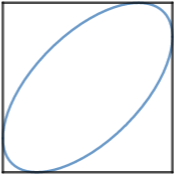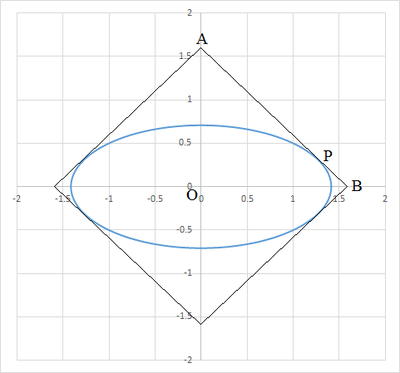Pi Day Ellipse

An ellipse has a semi-major axis along a diagonal of a square and is tangent to all the sides of the square.
If the ellipse has an area of π and the square has an area of 5 , then the semi-major axis of the ellipse is p for some integer p .
Find p .
The answer is 2.
This section requires Javascript.
You are seeing this because something didn't load right. We suggest you, (a) try
refreshing the page, (b) enabling javascript if it is disabled on your browser and,
finally, (c)
loading the
non-javascript version of this page
. We're sorry about the hassle.
4 solutions

Let us rotate the square by 4 5 ∘ , the center of the ellipse be the origin O of the x y -plane, the semi-major axis be a and semi-minor axis be b . Then the equation of the ellipse is a 2 x 2 + b 2 y 2 = 1 , where we can assign x = a cos θ and y = b sin θ . Since area of the ellipse is given by π a b = π , ⟹ b = a 1 .
Since the area of the square is 5 , then its side length is 5 and that of its diagonal is 1 0 . Let P be the point where the side A B is tangent to the ellipse. We note that the gradient of A B is − 1 and its equation is y = 2 1 0 − x .
The gradient of the ellipse at point P is − 1 . Differentiating the equation of the ellipse, we have:
a 2 2 x + b 2 2 y d x d y a 2 x a cos θ ⟹ tan θ = 0 = b 2 y = b sin θ = a 2 1 Note that d x d y = − 1 at P . ⟹ sin θ = 1 + a 4 1 , cos θ = 1 + a 4 a 2
From
y y + x a sin θ + a cos θ 1 + a 4 1 + 1 + a 4 a 4 1 + a 4 1 + a 4 2 a 4 − 5 a 2 + 2 ( 2 a 2 − 1 ) ( a 2 − 2 ) = 2 1 0 − x = 2 1 0 = 2 1 0 = 2 1 0 a = 2 1 0 a = 2 5 a 2 = 0 = 0 Multiply both sides by a Squaring both sides Rearranging
⟹ { a = 2 b = 2 1 , since a > b .
Therefore, p = 2 .
Great solution, thanks for sharing! I think you are missing a square root symbol on y = 2 1 0 − x (in the sentence starting with "Note that the gradient ...").
Log in to reply
Thanks, I have added it. I found that the answer for your other problem about the square and rectangle where we need to find n of n π to be n = 2 . Please check again.
Log in to reply
Here was my reasoning, maybe you can see where I went wrong or how the question can be written better:
Let B be the combined area of the blue sections and R be the area of the red section. Since both rectangle and square have an area of π , B + 2 R = 2 π , and since the area of the blue sections are 6 times the area of the red sections, B = 6 R . These two equations solve to R = 4 1 π .
Since the square has an area of π , its sides are π , so the red section has this side and a side equal to π R = π 4 1 π = 4 1 π , and the rectangle with an area of π has this side and a side equal to 4 1 π π = 4 π . Therefore, n = 4 .
Log in to reply
@David Vreken – OK, you are right. Sorry, I made a mistake.
Sorry I can't do the maths formulae nicely but..... Rotate the set-up till the semi-major axis is on the x-axis.
The ellipse has equation
p y^2 +x^2 / p = 1
And the top left side of the square y = x + sqrt (5) / 2
Now there must be ONE simultaneous solution so after reduction to one quadratic equation in x, the quadratic discriminant in terms of p must be zero.
I don't know how to write it....
It does work, I promise!
Since the area of an ellipse with a major axis a and a minor axis b is A = π a b , and this ellipse has an area of π , so b = a 1 . The equation of a vertical ellipse is b 2 x 2 + a 2 y 2 = 1 , and if b = a 1 , this is equivalent to a 4 x 2 + y 2 = a 2 .
Since the area of the square is 5 , its sides are 5 . Let the square be centered at the origin. Then the sides of the square are on the lines y = ± 2 5 and x = ± 2 5 .
Rotating the ellipse 4 5 ° to align with the square’s diagonal gives a new equation ( a 4 + 1 ) x 2 + 2 ( 1 − a 4 ) x y + ( a 4 + 1 ) y 2 = 2 a 2 . Since the ellipse is tangent to the square, the discriminant must be zero at y = 2 5 , so 4 ( 1 − a 4 ) ( 2 5 ) 2 − 4 ( a 4 + 1 ) ( ( a 4 + 1 ) ( 2 5 ) 2 − 2 a 2 ) = 0 , whose largest solution is a = 2 , so p = 2 .
Let put the center of the square as the origin of the coordinate (x,y). The area of the ellips is πab = π, so ab = 1, ..... (1) the equation of the ellips is x^2/b^2 + y^2/a^2 = 1, ........... (2), and the equation of tangent is : x + y = √5/√2 . ............... (3) Substitute y = √5/√2 – x, and a = 1/b, to eqs.(2) (b^4 + 1) x^2 - √10 b^4 x + (5/2 b^4 - b^2) = 0. Discriminant of this quadratics eqs. D = 0, then 2 b^4 – 5 b^2 + 2 = 0, b= √2